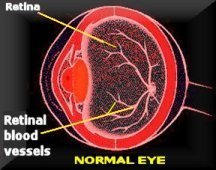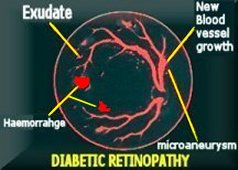|


What is diabetic retinopathy?
If you have diabetes, you probably know that your body can't use or store sugar properly. When your blood sugar gets too high, it can damage the blood
vessels (swells & leaks) in your eyes. This damage may lead to diabetic
retinopathy.
How Do one knows If he/she has Diabetic Retinopathy?
There are often no symptoms of early diabetic retinopathy therefore it will be difficult for you to
tell.
What are the different types of diabetic retinopathy?
Diabetic retinopathy is classified as either non-proliferative (background) or proliferative.
Non-proliferative retinopathy is the early stage, where small retinal blood vessels break and leak.
In proliferative retinopathy, new blood vessels grow abnormally within the retina. This new growth can cause scarring or retinal detachment, which can lead to vision loss. The new blood vessels may also grow or bleed into the vitreous humor, the transparent gel filling the eyeball in front of the retina. Proliferative retinopathy is much more serious than the non-proliferative form and can lead to total
blindness.
What are the signs and symptoms of Diabetic Retinopathy?
In the early form of diabetic retinopathy called non-proliferative or background retinopathy you might have no symptoms at all. In non-proliferative or background retinopathy leads to macular edema, you may notice a gradual blurring of your vision, and have difficulty doing close work such as reading,
knitting etc. You might have blurred vision.
If the abnormal blood vessels associated with proliferative retinopathy bleed, vision may become spotty, hazy, or disappear completely.
In later stages, the disease may lead to new blood vessel growth over the retina. The new blood vessels can cause scar tissue to develop, which can pull the retina away from the back of the eye. This is known as retinal detachment, and can lead to blindness if untreated. In addition, abnormal blood vessels can grow on the iris, which can lead to
glaucoma.
How to diagnose Diabetic Retinopathy?
* Your ophthalmologist can tell you if you show signs of diabetic eye disease by looking
at the inside of the eye (i.e. retina) with a special instrument called an ophthalmoscope.
* Using a special test called fluorescein
angiography. In this test, dye is injected into the body and then gradually appears within the retina due to blood flow & at regular interval
of time retinal photographs are taken with digital retinal camera.
Evaluating these pictures tells your doctor how far the disease has progressed.

Is there any way to prevent Diabetic Retinopathy?
* Keep your blood sugar under good control.
* Monitor your blood pressure and keep it under good control.
* Maintain a healthy diet.
* Exercise regularly.
* See your eye doctor for a dilated eye exam at least once a year.
* If you notice blurring of your vision, or have difficulty doing close work such as reading,
or if your vision becomes spotty or hazy, see your eye doctor immediately.
Diabetic retinopathy can be treated, and vision loss prevented if it is caught early
enough.
What treatments are available for Diabetic Retinopathy?
The best treatment is to keep your diabetes under
control
Laser photocoagulation is one of the most common treatments for diabetic retinopathy. In this kind of surgery, short spots of the laser's beam are directed at the retina to seal leaking blood vessels.
The laser beam spots can also be scattered through the sides of the retina to reduce abnormal blood vessel growth
(neo-vascularization) and help to seal the retina to the back of the eye. This can help prevent retinal detachment.
Vitrectomy:
If blood gets into the vitreous humor, your doctor might want to perform a procedure called a vitrectomy.
As with all surgery, there are risks associated with surgery for diabetic eye
conditions. Complications are unusual, but can include:
*Infection
*Bleeding
*Elevated pressure in the eye, which can lead to glaucoma, retinal detachment or scarring.
*Cataract
*Loss of vision
|